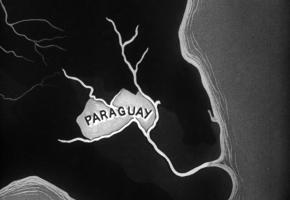“It’s Derbez, man, no mamés,” my friend Fito babbled over the phone at 11:15 pm on a Thursday, minutes before the interview. As an expert on Mexican pop culture, he was helping me prepare. “This is a biggie! Next, you’re gonna get Al Pacino.” I couldn’t help but agree.
“I’ve gotta go, man.”
I hung up and joined the waiting room. Unlike Fito and the rest of my Mexican friends, I didn’t grow up with Eugenio Derbez’s brazen slapstick comedy fizzing from the boxy television sets of my childhood. So, it was strange that I felt nervous. As I waited to be let in, my hands trembled. I made another espresso with sugar to settle myself down.
Moments later, Derbez’s face appeared on my laptop screen. He was smiling warmly from a sun-drenched open-plan kitchen in Mexico City, his birthplace. Paintings of the countryside hung behind him. Even with a whitish goatee, I struggled to grasp how this smooth-skinned peppy man was already sixty-two. I asked him how he was doing. He responded, “Amazing!” in a tone so ferociously upbeat I was jolted into remembering that for the last ten years he’s been living in Los Angeles.
We spoke ahead of the release of Season 3 of Acapulco (now streaming on Apple TV+). The series - half in English, half in Spanish - is a feel-good comedy set mostly in the 1980s. It tells the rags-to-riches story of Máximo Gallardo: a kid from the streets of Acapulco whose life is forever changed after getting hired as a pool boy at the town’s most glamorous hotel, Las Colinas. Máximo’s brave risk-taking and optimism lay the groundwork for him to become a self-made billionaire. His story is a neoliberal economic fairytale, where hard work is the noble route out of poverty. While newcomer Enrique Arrizon was cast in the main role as Máximo in the 80s, the present-day mogul is played by Derbez, who’s also an executive producer.
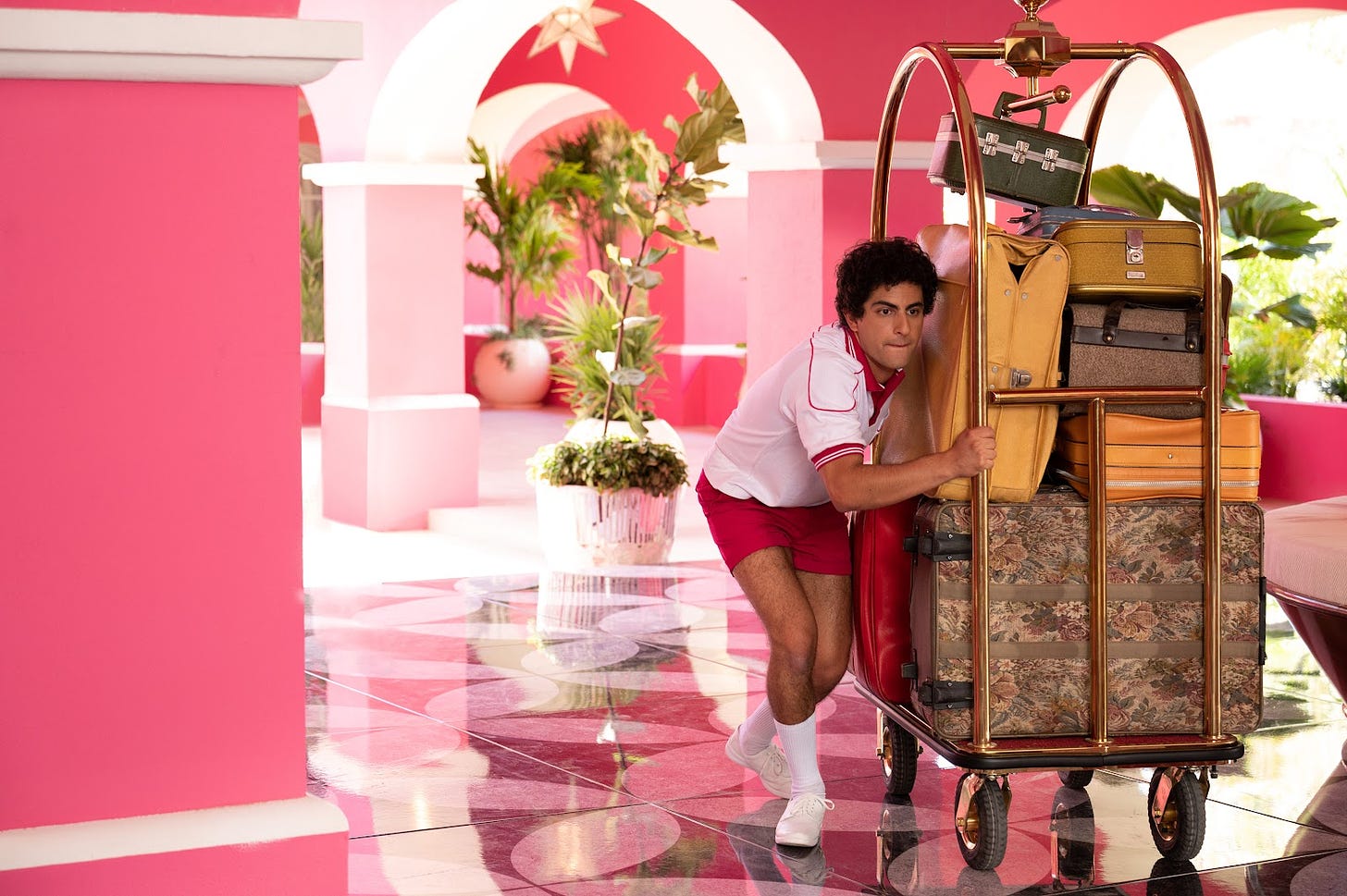 Enrique Arrizon as the younger Máximo
Enrique Arrizon as the younger Máximo
Shyal: Congratulations on a third season. You do a great job of steering the ship as the narrator, driving the storyline forward, while allowing younger talent to shine and be the funny ones. What’s it like not being the funniest guy on set?
Eugenio: It was strategically planned so I could just be the narrator and shoot for two or three weeks instead of three months. But I started to feel FOMO. I wanted to be in it more, especially in the past, where the fun happens. I wanted to be funny too.
S: Did that mean that you didn't get to go on set much?
E: When I arrived, the first place I wanted to visit was the set and this pink, beautiful hotel. But for story reasons, I had to shoot in my car. But let me tell you, I'm in awe of the amazing work they did; they painted the entire hotel. It was not originally pink. It was just natural white paint and the art department built everything.
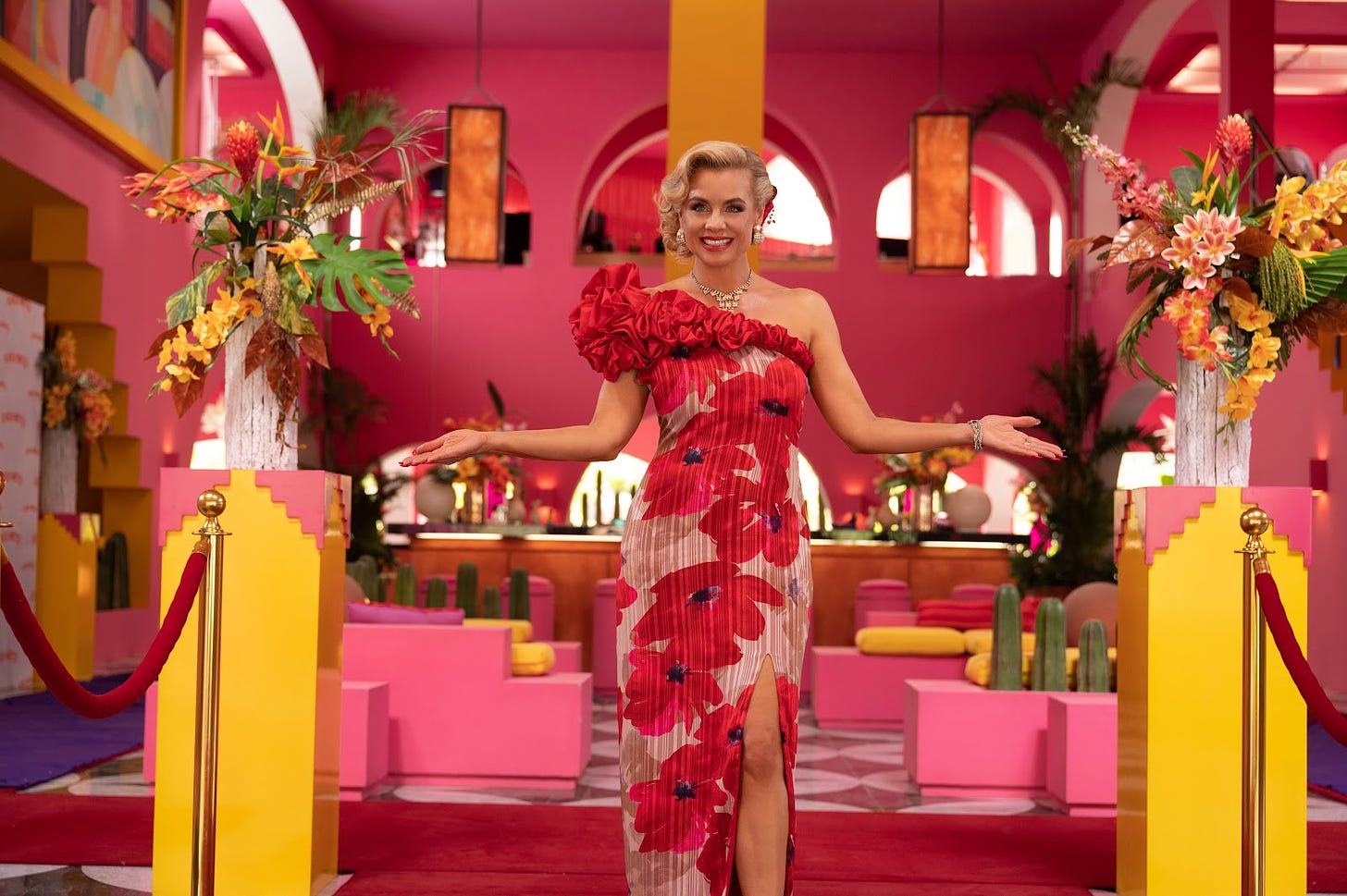 Jessica Collins as Diane Davies, the owner of Las Colinas
Jessica Collins as Diane Davies, the owner of Las Colinas
S: Were you in Acapulco in the 80s?
E: I grew up going to Acapulco on summer vacations, Christmas vacations. If you asked me, do you want to go to Disneyland or Acapulco? I would say Acapulco. I kissed my first girlfriend there. In the 80s and 90s, it was the place to go. Hollywood stars, Elvis Presley, Elizabeth Taylor, Frank Sinatra, everyone was in Acapulco. It was the perfect mix. During the day, it's family-friendly. But at night... you can experience the wildest parties. There were huge mansions of the Sultan of no sé dónde, and the king from here...
It’s no coincidence that Eugenio vacationed amongst the rich and famous in Acapulco. His mother was the actress Silvia Derbez (1932-2002), a household name who starred in the country’s very first telenovela, Senda prohibida (1958). Eugenio practically grew up on set. By the age of twelve, he started getting extra work, before bagging his first TV roles. He aspired to be a dramatic actor, but he had talent as a comic, straddling the line between goofiness and wit. In the 90s and early 2000s, Derbez’s string of sketch comedy shows defined a generation. Not unlike Sasha Baron Cohen or Catherine Tate, his characters were imitated by high-schoolers at the backs of buses and office clerks around water coolers across the country.
For his voicing of Donkey in Shrek (2002), Derbez negotiated a contract with Dreamworks which granted him the creative freedom to write his own jokes into the Latin American Spanish version. With Shrek, Derbez was catapulted to fame beyond his native Mexico and quickly became a star for Hispanic audiences in Latin America and the US. He played opposite Adam Sandler in Jack and Jill (2011), before writing, directing, and acting in his own productions. Today, he has a star on the Hollywood Walk of Fame, he was a cast member of the Best Picture Oscar-winning Coda (2021), and most recently, he starred in his first major dramatic role as an inspirational schoolteacher on narco-controlled terrain in Radical (2023).
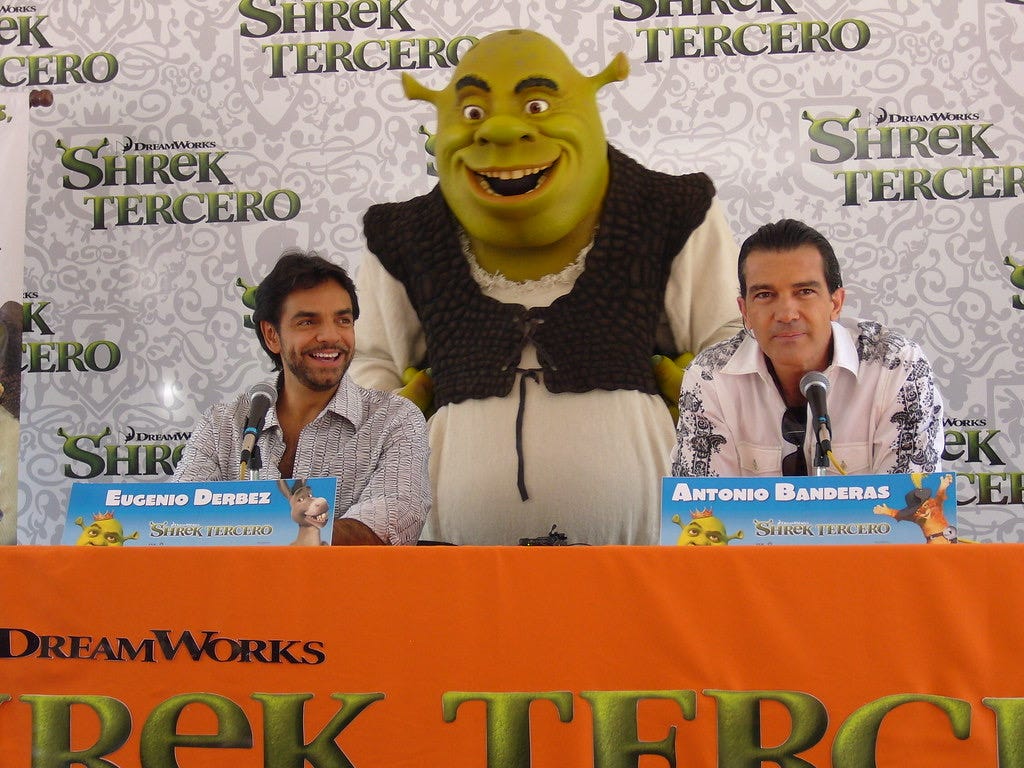 Derbez and Antonio Banderas promoting Shrek the Third
Derbez and Antonio Banderas promoting Shrek the Third
S: When I told my friends in Mexico that I was going to interview you, they flipped out. You're somebody they grew up with, who was in the living room. Your characters were always there. I did some research. I saw your interview with Vicente Fox, the [former] President. I think Armando Hoyos is an amazing character.
E: One of my favourites. I can't translate the humour of Armando, but if you speak Spanish and you get it, it's really funny.
S: Your humour in Spanish is precise and relies on the fact that you have a strong cultural understanding of how to manipulate language to make people laugh.
E: Mm hmm. Mm hmm.
S: How has it been for you to express your sense of humour in English?
E: Every show I did in Mexico played with language. My humour was based on double entendres. And when I moved to the US, I didn't know how to play with words. I had to start taking acting lessons in English to get the different rhythm. For example, the directors, after watching my material in Spanish, were like: Don't open your eyes too much. Don’t move your eyebrows. Do less. So, trying to be funny in English has been a very big challenge.
In my opinion, Derbez is funniest in Spanish as Armando Hoyos: an irritable intellectual with googly-eyes behind the glasses. Armando reads wisecrack definitions from his Diccionario de la Real Epidemia de la Lengua (literally: ‘Dictionary of the Royal Tongue Epidemic’), a wordplay of the Diccionario de la lengua española de la Real Academia Española (‘Dictionary of the Spanish Language of the Royal Spanish Academy’). There’s nothing funny about that in English. Eugenio’s right. You can’t translate it. I have left a clip below, however, of the skit with Vicente Fox before he became President of Mexico.
Speaking of the Mexican presidency, Derbez made headlines in March when he revealed to El País that he got a call asking if he was interested in running in this year’s election. Despite having lived outside of Mexico for the last decade, Derbez became something of an overnight political figure after publicly opposing President Lopez Obrador’s US $15 billion touristic ‘Mayan Train’ project in the south. Derbez stood against the train because of the threat it poses to the natural environment, particularly the Yucatan peninsula’s cenotes (sinkholes holding water). The President argues that the train (now running) promises to create jobs in the country’s poor south. Only time will tell. Derbez, adored by the much of the nation, and with an Instagram following of over 20 million, might have made a formidable candidate. But he wasn’t interested. Besides, he told El País that he doesn’t know anyone in politics.
S: What led you to move [to the US]? It seems like a crazy adventure, especially when you had such a successful career [in Mexico]. What made you pack your bags?
E: I always dreamed of making movies in Hollywood. And in 2013, I did a movie called Instructions Not Included that I directed, produced, and starred in. It became the highest grossing Spanish-language film ever, worldwide. It was the biggest opening for a movie in Spanish in the US. From one day to the other, agents started calling. They invited me to go on Jimmy Fallon, Larry King, Seth Meyers, all the late night shows. So I shut down my life in Mexico from one month to the other. I decided to move to the US, leaving behind my office, my TV shows. I decided to take a leap of faith and start over again.
S: I've heard you talk about wanting to create roles that challenge the stereotype that Mexicans are violent criminals. What are some aspects of Mexican culture that you wish had more of a spotlight in mainstream media?
E: That's one of the reasons I decided to pitch [Acapulco] to Apple; because I was tired. Since I moved to the US, they offer me the same roles: the narco, the drug lord, or best case scenario, the gardener. But we Mexicans are more than that. I was tired of watching the news and seeing all the negative things like crime, violence, killings, kidnappings. So, I started producing my own shows and films. I wanted to show a Mexico, like the one in Acapulco, where you see beautiful beaches, colour, amazing food. I wanted to show Mexico in a positive way. And also, I was tired as a parent. Every time I want to watch TV with my nine-year-old, it's impossible because all the series nowadays are violence, blood, sex, murders. Acapulco is a series you can watch with your whole family, with your kids and your grandma. That's the kind of television I want to show the world. And that's the kind of Mexico I want to show the world.
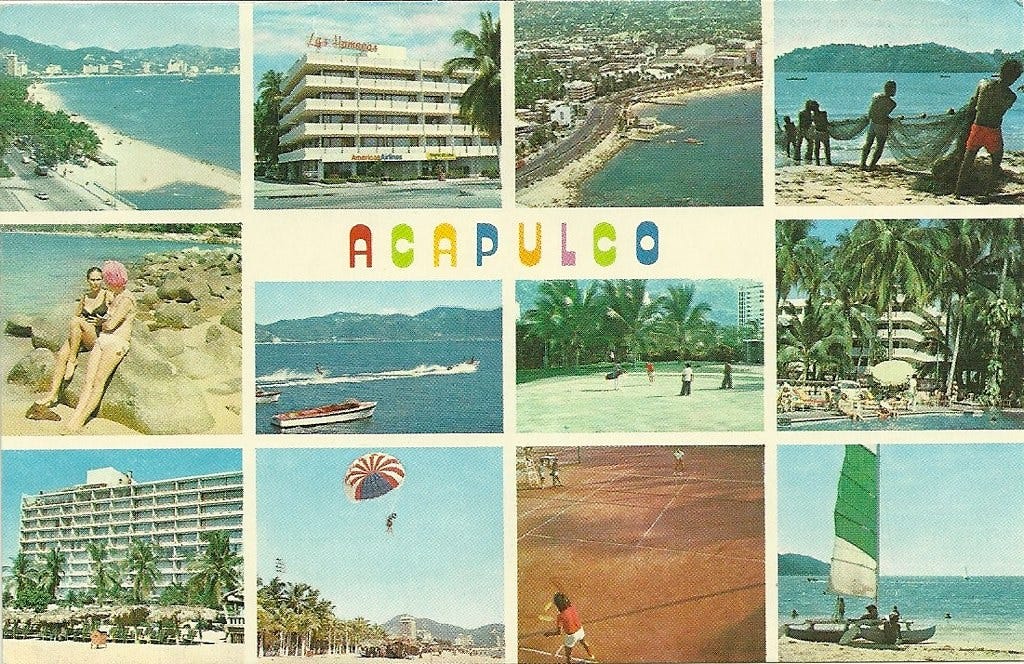 A postcard from Acapulco circa 1979
A postcard from Acapulco circa 1979
We had overrun our fifteen minute time slot and I could see the publicist had been messaging me several times asking me to wrap. it. up.
S: Thank you so much, Eugenio, really. Is that a Dr. Atl behind you, the painting?
E: Yes. This is not my apartment, but I was surprised because this is a Dr. Atl and this is a Botero. Look at that. And there's a Dalí in the bathroom. It's crazy. This place is amazing!
S: It's incredible. Are you in la Ciudad de México?
E: In Mexico City, exactly. I'm in Polanco right now. And I'm going tonight to Coyoacán. I have a dinner meeting.
S: Enjoy. Get a nieve afterwards and walk around. Maybe nobody will notice you. Maybe you'll go like a complete stranger.
“Acapulco” season three is available on Apple TV+ every Wednesday through June 19.




